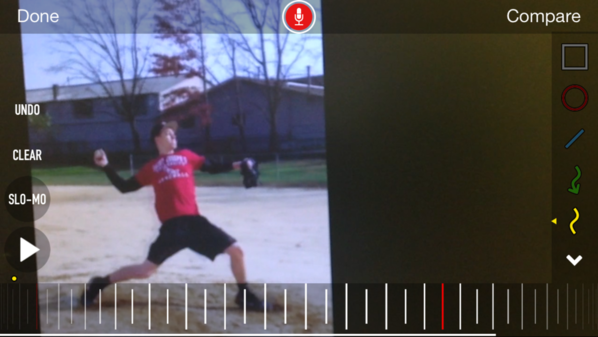I like what's being said here but I don't think that something back foot slider said is getting enough attention. BOF hit on this as well, and had a lot of great advice for you.
I like the comparison to Greinke, and it would be a good idea for you to look at the video that picture came from.
The bottom half looks very similar, and I agree with others that the hips look pretty good. The major difference is that your pitcher's arms (both of them) remain "disconnected" for too long.
In my opinion a big part of this for him is his glove side. After it flies out and up, it just sort of dies and falls down by his side. Watch Greinke again in that video and notice how his glove behaves in a similar way upon hand break, but much more aggressively and "connected" as he gets close to foot strike. His glove arm is not just "along for the ride" or "passive", it's taking action to begin balanced rotation of the shoulders around the spine. This is one way to truly "rotate" into the throw, rather than just "turning" into the throw.
I am not advocating "pulling" the glove in any direction at all, simply to activate it a little better to provide more strength to the front, which will translate to the throw.
I agree with others that the shoulders are starting a little too early, and I really believe the front side's "falling to the side" is a cause. I haven't posted here before and I can't figure out how to post a picture, but stop the video on the exact frame of solid foot plant.
If I do that, and cover the top half of the pitcher, I see a really good position. However, the top half in that frame has leaked a lot of energy and lost it's rotational power. There may be more than one reason why, but it's very common for a weak glove side to cause this.
It's my opinion that the glove here is just leaking to the side, pulling the front shoulder with it (thus opening the shoulders prematurely), and creating a less than optimal connection to the body.
I really think that if you get some more useful rotation and connection from the front side, it would really help the shoulders be more delayed (by not being pulled early) and I think it would also help him throw a little more downhill.
Some things that might help;
1) simply work on a more aggressive/connected glove side. Hold a 2 pound med ball in that hand when you pitch, and practice bringing it into the body a little better. It will change upper body rhythm a bit, so work on drills which sync the arms in the new rhythm. Also, as HOF said, if the thumb stays "down" it will help.
2) start hips toward home slightly earlier, a lot of his weight is still on top of his post leg as the knee starts down, so he can start the hips a bit sooner. Faster hips equal better connected extremities. Draw a line straight up from where you think most of his weight is at hand break and do the same with Greinke.
3. Strengthen the core. He looks strong and if you're doing med ball work keep doing it. The first stabilizer in the process of transferring energy (to be general) is the legs, the second is the core. If the core is not trained as a stabilizer properly (not just linear strength like crunches, but rotational stabilizing like TAP's slam net and other med ball stuff), energy from his good bottom half will leak. I think the leak is happening because of poor lead arm action, but this is another place to look.
He looks really good to me, he just needs to keep working hard. There are some ways to work on the hips like you're talking about but it's a little complex to describe here, and I don't see a reason to work on them until the upper half is working.
Feel free to contact me if I haven't communicated effectively, consider what I've said as simply one more opinion in the middle of all of these other great ones. Hopefully you can use a piece of it. Good luck out there!




